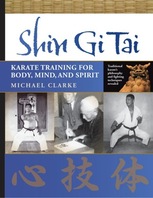
Shin Gi Tai: Karate Training for Body, Mind, and Spirit by Michael Clarke (YMMA: 2011)
Michael Clarke’s Shin Gi Tai: Karate Training for Body, Mind, and Spirit is simultaneously an auto-ethnography of a prominent Karateka, a series of history lessons on the system as a cultural practice, and an anthropological analysis of the current state of karate from a very definite perspective. Instructionally, it is not so much a “how to” book, but a guideline for those who are finding their own way (though there are detailed descriptions of example exercises).
The fact that this book is in dialogue with the writings of both Shoshin Nagamine and Rory Miller may be enough to recommend it. This meeting of both the most traditional of masters and the most cutting edge writing on the realities of modern violence important in and of itself. Clarke’s credentials as a master level Karate practitioner and a self-confessed reformed “street fighter” position him to provide an authoritative discourse on the personal and psychological benefits of Karate along with the tools to analyze the combative potential of traditional training. He also takes a refreshing stand against politics within styles and organizations and lays out the many ways in which they do not serve the students of the art.
The book is divided into six main section, as well as an introduction, conclusion, notes, a glossary, and various lists of resources. These are, the Dojo, Shin (Mind, Spirit), Gi (Technique), Tai (Body), the Future for Karate, and Stories of Three Great Men (Kosaku Matsumora, Kanryo Higaonna, and Gichin Funakoshi).
There are several particularly valuable passages in the section on the dojo wherein Clarke offers a comprehensive explanation of the overarching purpose and benefits of etiquette in Karate training. Here Clarke describes the larger goals of etiquette without being prescriptive of a specific model. His excellent analysis of the relationship between etiquette and cultivating awareness (zanshin) brings to light an essential aspect of Karate training that is absent from all too many texts.
The section on the mind provides insights into the psychology and philosophy of training in terms of what is required to train in traditional Karate as well what is gained. The technique section follows with a framework for cultivating attributes necessary for proper execution, which in turn is followed by tools to interpret kata. The next chapter, dedicated to the body, outlines traditional training methodologies that develop a strong body capable of delivering the techniques with power.
Throughout the book there are several cultural comparisons between Okinawan and Japanese Karate and how these two branches evolved. The many descriptions of the historical and cultural context of the art in Okinawa is particularly rewarding to read since, as Clarke points out, Karate was disseminated to the modern world largely through the efforts of the Japanese rather than the Okinawans. The book goes into great detail on the Okinawan context of the art, this includes history, differences in training methodology, cultural context, and philosophical differences.
While Clarke’s knowledge and expertise are indisputable and there is a tremendous amount of valuable information in the book, it is unclear who exactly Shin Gi Tai is for. Clarke is a man of strong opinions and is not shy about expressing them. This is both a strength and a weakness. Several sections of the book may be a bit much for those still in the kyu ranks, while more advanced students may either already involved in a type of training he advocates or be repeatedly reading that their training is what is wrong with Karate today. The book often appears to be preaching to a very specific (and devout) choir. There is sometimes a feeling of prosthelytizing to much of the book, alongside somewhat self-contradictory admonitions that student find their own paths and reassurances that all choices are respected. Several times in the book he discusses training progress not in years but in decades, and one is forced to wonder who his target audience is. There also exists the field-wide problem of advocacy-related fallacies: there are qualities and benefits that he attributes exclusively to Karate that exist in numerous other training methodologies. That said, these sort of statements exist in many martial arts texts (and texts relating to numerous other movement systems), and are forgivable as they reflect a deep-rooted love of the art, and that enthusiasm is what fuels the many positive qualities of this book.
Shin Gi Tai is a valuable book for anyone studying Okinawan or Japanese Karate, as well as a valuable text for those engaged in an academic study of the art and its traditions, methodologies, and cultural history.
 RSS Feed
RSS Feed